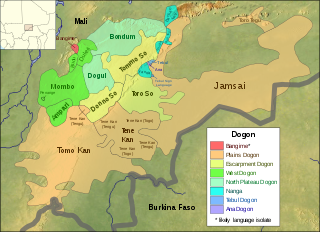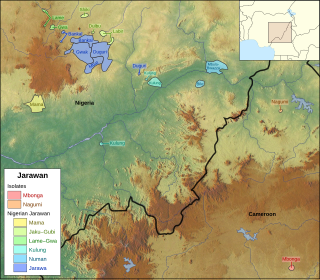Related Research Articles

The Dogon are an ethnic group indigenous to the central plateau region of Mali, in West Africa, south of the Niger bend, near the city of Bandiagara, and in Burkina Faso. The population numbers between 400,000 and 800,000. They speak the Dogon languages, which are considered to constitute an independent branch of the Niger–Congo language family, meaning that they are not closely related to any other languages.
The Adamawa languages are a putative family of 80–90 languages scattered across the Adamawa Plateau in central Africa, in Nigeria, Cameroon, Central African Republic, and Chad, spoken altogether by only one and a half million people. Joseph Greenberg classified them as one branch of the Adamawa–Ubangi family of Niger–Congo languages. They are among the least studied languages in Africa, and include many endangered languages; by far the largest is Mumuye, with 400,000 speakers. A couple of unclassified languages—notably Laal and Jalaa—are found along the fringes of the Adamawa area.

The Dogon languages are a small closely-related language family that is spoken by the Dogon people of Mali and may belong to the proposed Niger–Congo family. There are about 600,000 speakers of its dozen languages. They are tonal languages, and most, like Dogul, have two tones, but some, like Donno So, have three. Their basic word order is subject–object–verb.
Escarpment Dogon is a continuum of Dogon dialects of the Bandiagara Escarpment, including the standard language. There are three principal dialects:
Jamsay Dogon is one of the Dogon languages spoken in Mali, and the only one spoken in Burkina Faso apart from a few villages of Tomo Kan. It is one of the plains languages spoken in Dogon villages outside the Bandiagara Escarpment. It is a major language in Koro, at the south end of the escarpment, and stretches as far north as Douentza. It is not mutually intelligible with other Plains Dogon languages, but is widely known as the prestige variety due to its use as the language of radio broadcasts. Dialects are Domno tegu, Gono tegu, Bama tegu, and Guru tegu; their degree of mutual intelligibility has not been recorded. Domno is the standard dialect, and considered the purest; Guru (Koro) is the dialect of that town.

Bangime is a language isolate spoken by 3,500 ethnic Dogon in seven villages in southern Mali, who call themselves the bàŋɡá–ndɛ̀. Bangande is the name of the ethnicity of this community and their population grows at a rate of 2.5% per year. The Bangande consider themselves to be Dogon, but other Dogon people insist they are not. Bangime is an endangered language classified as 6a - Vigorous by Ethnologue. Long known to be highly divergent from the (other) Dogon languages, it was first proposed as a possible isolate by Blench (2005). Research since then has confirmed that it appears to be unrelated to neighbouring languages. Heath and Hantgan have hypothesized that the cliffs surrounding the Bangande valley provided isolation of the language as well as safety for Bangande people. Even though Bangime is not related to Dogon languages, the Bangande still consider their language to be Dogon. Hantgan and List report that Bangime speakers seem unaware that it is not mutually intelligible with any Dogon language.

Dogon country is a region of eastern Mali and northwestern Burkina Faso populated mainly by the Dogon people, a diverse ethnic group in West Africa with diverse languages. Like the term Serer country occupied by the Serer ethnic group, Dogon country is vast, and lies southwest of the Niger River belt. The region is composed of three zones: the plateau, the escarpment and the Seno-Gondo plain.

Jarawan is a group of languages spoken mostly in Bauchi State, Nigeria, with some also scattered in Plateau State, Taraba State, and Adamawa State in the same country. Two related languages formerly spoken in Cameroon are now extinct but are believed to have belonged to the group. This connection between Nigerian and Cameroonian Jarawan is attributed to Thomas (1925). Whether Jarawan languages are best classified alongside other Bantu languages or among non-Bantu Bantoid languages is a matter of ongoing debate. A number of descriptions and classifications in the early 20th century suggest that they be may historically related to Bantu languages but not necessarily Bantu themselves. Other perspectives based on lexicostatistic modeling and other phylogenetic techniques for language comparison argue instead that Jarawan languages are properly classified alongside Zone A Bantu languages (A31-A40-A60). For classifications based on these more recent studies, see for example Blench (2006), Piron (1997), and Grollemund (2012).
Ana Dogon, or Ana Tiŋa, is a recently discovered Dogon language spoken in Mali. It was first reported online in 2005 by Roger Blench.
Budu Dogon or Bunoge, also known as Korandabo, is a recently discovered Dogon language spoken in Mali. It was first reported online. The plural suffix on nouns is closest to Kolum so, suggesting it should be classified as a West Dogon language.
Bankan Tey Dogon, at first called Walo-Kumbe Dogon after the two main villages it is spoken in, also known as Walo and Walonkore, is a divergent, recently described Dogon language spoken in Mali. It was first reported online by Roger Blench, who reports that it is "clearly related to Nanga", which is only known from one report from 1953.
Naŋa dama, also known as Naŋa tegu, is a Dogon language spoken in Mali that is only known from one report from 1953. Roger Blench reports that its nearest relative is the recently described Walo–Kumbe Dogon, "with which it shares both lexicon and the feature that many nouns have a final -m." Hochstetler thinks they may be the same language. It may be close to Yanda Dogon (Blench) or Jamsai tegu (Hochstetler).
Yanda Dogon is a Dogon language spoken in Mali. It is reported to be lexically similar to Nanga, which is only known from one report from 1953.
The Tebul language, also known as Tebul Ure, is a Dogon language spoken in Mali by the Tebul U. It was first reported under this name online by Roger Blench, who erroneously reported that it appears to be the same as a language called Oru Yille in the literature. This mistaken name instead means 'two words' in the Tebul language.
The Dogul language, Dogul Dom, is a Dogon language spoken in Mali. It is closest to Bondum Dogon, though not enough for mutual intelligibility.
The Bondum language, Bondum Dom, is a Dogon language spoken in Mali. It is closest to Dogul Dogon, though not enough for mutual intelligibility. Dialects are Kindjim and Nadjamba.
Duleri Dogon or Duleri Dom, also known as Tiranige dige, is a Dogon language spoken in Mali.
Mombo Dogon is a Dogon language spoken in Mali. Helabo and Miambo are dialects.
The Toro language, Tɔrɔ tegu 'Mountain speech', is a Dogon language spoken in Mali. It is closest to the prestige variety of Dogon, Jamsay tegu, though speakers deny they are related and understand little of it. Hochstetler report difficulties in comprehension between Tɔrɔ tegu and one of the western Plains Dogon languages, Tomo kan.
The Dogon dialects of the western plains below the Bandiagara Escarpment is Mali are mutually intelligible. They are sometimes called the Kan Dogon because they use the word kan for varieties of speech. The dialects are:
References
- ↑ Ampari at Ethnologue (18th ed., 2015) (subscription required)
